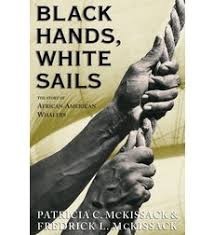Details the amazing courage and bravery of the black sailors who, desperate to escape slavery, became whalers on the dangerous high seas, as well as Frederick Douglass, Paul Cuffe, and other significant figures in the whaling industry and abolitionist movement.---from the publisher
192 pages 978-0590483131 Ages 10 and up
Keywords: African American, whaling ships, sailors, slavery, abolitionist movement, Black Lives Matter, African American author, diversity, diverse books, multicultural biography, Diversity: Resilience and Oppression, American history, 10 year old, 11 year old, 12 year old, 13 year old, 14 year old, nonfiction
****************
Other Reviews:
This fascinating look at the convergent histories of whaling and the abolitionist movement weaves seemingly disparate threads into a detailed tapestry. The authors trace the whaling industry from its colonial New England roots through the end of the nineteenth century, establishing it within a strong political, social, and economic context. The connections they describe are illuminating, including the use of whaling ships as vehicles on the Underground Railroad and as weapons in the blockade of two Confederate harbors. Whaling was a harsh profession that offered, if not equality, at least greater opportunity for African American men. Drawing heavily from primary sources, the McKissacks celebrate the accomplishments of such sailors, captains, shipbuilders, and inventors as Lewis Temple, the blacksmith who designed the first barbed harpoon. Less-skilled readers may have difficulty following the expansive narrative that pulls in details from several different angles, but history buffs and researchers should find the book's complexity rewarding. Appended is information on whale species, a time line, and a bibliography. Randy Meyer on Book List
***********
Grade 6-9-A well-researched and detailed book chronicling the contributions of African Americans to the whaling industry. Many were drawn to jobs on whaling ships throughout the 1600-1800s, for while conditions were difficult, they were preferable to slavery. The authors go to great lengths to draw out the roles of African Americans, and while many of these connections are eye-opening, they are sometimes tenuous. The first half of the book, an introduction to the whales and the business surrounding their hunting, features significant men such as Prince Boston and Paul Cuffe, but also some who were less directly involved. Frederick Douglass did briefly work as a ship's caulker but many pages are devoted to describing aspects of his life that are irrelevant to whaling. Midway, the emphasis shifts to interesting aspects of life aboard ship, explaining phrases we use today that derive from whalers, superstitions of the seas, sailing songs and shanties, the story of the famous Essex, and the role of whalers in the Revolutionary and Civil Wars. While the story becomes much more engaging at this point, the role of African Americans seems to have diminished importance as race is only occasionally mentioned. Overall, though, as an important and under-explored aspect of both African-American and nautical history, this book merits a place on the shelves in larger libraries and in African-American collections. However, for a more fascinating look at whaling, and one that integrates the African-American story along with the many other participants, look to Jim Murphy's Gone A-Whaling (Clarion, 1998).
Andrew Medlar, Chicago Public Library, IL in Library Journal






